Williams College Science Renewal Project
With tremendous growth in the sciences and the need for new research, teaching, and equipment space, Williams College in Williamstown, Massachusetts, sought to expand its existing science center to serve the educational demands of the science departments and their students. Nestled within the Berkshire mountains, the original campus buildings are modestly scaled pavilions set in the landscape and define a network of courtyards and outdoor spaces. While recent mega-building clusters were added to the campus, the college favored adding two modestly scaled buildings more in keeping with the original campus fabric over creating another singular megastructure. The buildings could still physically connect to the existing science center via bridge connections but would frame and shape the interconnected landscape that forms the spirit of the campus.
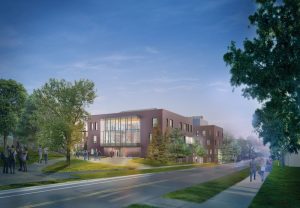
Payette Associates Inc., the architect and planner, and Simpson Gumpertz & Heger Inc. (SGH), the structural engineer, designed two buildings to revitalize the science campus. To the south, the Hopper Science Center, completed in 2018, provides new research space for the Biology, Chemistry, and Physics departments and houses new machine shops and an imaging facility. To the north, the Wachenheim Science Center was constructed on the old Bronfman Science Center site and provides research and teaching space for the Geosciences, Psychology, Mathematics, and Statistics departments. This article focuses on the structural design of the Wachenheim Science Center, completed in February 2021.
Design Overview
One of the design goals for the project was the ability to view the mountains from within the science quad. The building notches itself below grade into the bedrock to accomplish this goal. On this gradually sloping site, three and a half stories rise above grade while two and a half levels sit below. The foundation walls extend about forty feet below grade on the sides of the building, where the grade is the highest. The water table is approximately sixteen feet above the bottom of the basement slab elevation. The 26-inch-thick foundation walls and 4-foot-thick structural mat slab constitute the shell of the multi-story deep basement. Shear reinforcement ties in areas of high earth pressure shears are central to optimizing the volumes of wall concrete and reinforcement.
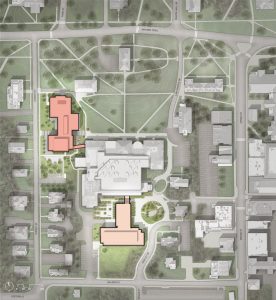
The above-grade stories include classrooms, research laboratories, and office spaces. There is a small mechanical penthouse on a portion of the roof. The superstructure consists of structural steel framing acting compositely with a concrete slab on metal deck. A 4½-inch-thick reinforced normal weight concrete slab on a 3-inch-deep metal deck achieves an uncoated two-hour fire rating for the laboratory chemical control areas, improves vibration performance for microscopy work, and increases flexibility for current and future floor penetrations typical of laboratory occupancies. There are large areas of depressed slabs within the floorplates to accommodate a variety of floor coverings, including locally quarried stone tiles. Dropped steel beams, bolsters, and supplemental deck support angles enabled the complex layout and varying depths of the recesses.
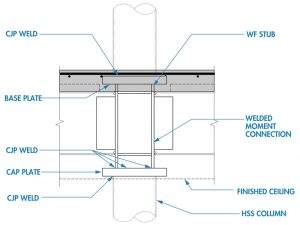
The architectural layout and the column grid often do not align from floor to floor because of the mixed-use of Wachenheim. Each level has a number of column transfers; some occur at Architecturally Exposed Structural Steel (AESS) round HSS columns. All connections and splices at these columns fit within the depth of the ceiling cavity to maintain the clean HSS aesthetic.
Moment frames provide the building’s lateral load resistance with minimal interference with the building’s complex program. Wind interstory drift control governs the design of the frames. Many of the moment frames have AESS round HSS columns. At the connections, the round columns transition to wide flange column stubs set within the ceiling depth to provide pre-qualified beam-column moment connections and improved panel zone shear strength without compromising the aesthetics of the exposed columns.
Below Grade
Among the suite of below-grade classrooms is a 212-person auditorium that will be a valuable asset for the sciences. The auditorium floor is a sloping, formed stepped slab that spans to sloping reinforced concrete raker beams supported by concrete walls. Column transfers around the auditorium space allow unobstructed views. The design team studied various framing options’ varying the location and level of column transfers for the four floors above the auditorium. The adopted scheme has the roof and two stories frame to a column that bears on a 50-foot-long transfer girder at Level 2. Other 50-foot-long girders carry the loads of the roof of the auditorium and of Level 1 to perimeter columns and the foundation wall. This hybrid solution created an efficient compromise of steel tonnage, serviceability, functionality, and constructability.
Creating “Lightness”
Some classrooms were forced below ground despite a desire for exterior views and natural light in all occupiable spaces. The design team added an at-grade exterior glass walk system on the east and west sides of the building to get daylight into these spaces. The glass walkway bears on sloping steel plates that frame between the floor framing and the foundation wall. A combination of tapered bolsters and concrete curbs support the sloped steel plates and glass structure.
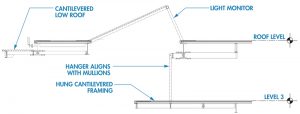
The building is organized by a main circulation spine, reinforced with a central staircase running alongside it, with hubs of departmental and student social spaces that pinwheel off. These hubs of collaboration space are what give the building its life force. In addition, each department has a double-height volume to mark the heart of the department, giving it an identity and a shared space for faculty and students to congregate. To create these living rooms, spaces needed to be open and column-free to be filled with tables, soft seating, chalk and marker boards, and to produce a collaborative, collegial, and academic environment. Two light monitors provide additional natural lighting, one of which is above the building’s central stair.
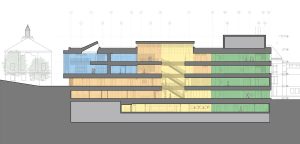
The north light monitor aligns with the double-height atrium space in the Math Department. The double-height space creates an open atrium between Level 2 and the roof. The Level 3 floor framing hangs from the roof framing, which also supports the light monitor framing, to create additional column-free space on Level 2. For this intertwined area, floor vibration and deflection control the governing design criteria, requiring stiffening of Level 3 and the ultimate supports on the roof.
The Psychology double-height atrium is approximately 30 feet by 30 feet in plan and has a double-height curtain wall on the north and east sides. Wide flange columns below Level 2 transition to a series of ganged small hollow structural steel tubes fitting within the backup framing for the brick piers. These eliminate the encroachment of a column cover in the corner of the space and minimize the visual impact of structural columns. The HSS columns bear on the stiffened slab edge at Level 2, run unbraced past Level 3, support the roof, and provide lateral support for the facade systems.
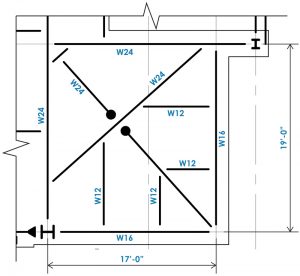
There is a column-free entry in the southwest corner of the building. The design team studied various framing options to determine the most efficient system that could accomplish the design intent. Instead of a single massive column transfer girder at Level 1, the team opted for cantilevered floor framing at each level.
Connectivity to Campus
While the Wachenheim is a standalone structure, it connects to the existing science center via a pedestrian bridge to provide a sheltered pathway during the Berkshire winters and maintain a physical connection to the rest of the sciences. The bridge is clad in a curtain wall and is structurally independent from the existing Thompson Biology center with an expansion joint between the structures. Directly below the bridge, there is a utility tunnel between the two buildings. The bridge springs off the new Wachenheim Center to a new column that bears on a pre-existing grade beam over the tunnel’s roof. The primary bridge gravity structure is on Level 3. Architecturally exposed plate columns behind the bridge curtain wall mullions act as hangers to support Level 2 and as columns to support the roof. The scheme minimizes the depth of structure and increases the transparency of the bridge at Level 2 and the roof. For wind and seismic loads, the bridge cantilevers horizontally off the Wachenheim center via diaphragm action of the floor and roof decks.
The Hopper and Wachenheim Science Centers’ construction, two modestly sized buildings integrated into the existing science center complex via pedestrian bridges and tunnels, provides Williams College additional space and resources for various science departments. By focusing the Wachenheim Center on housing the Geosciences, Psychology, Mathematics, and Statistics Departments, the design team provided distinct educational and collaborative spaces tailored to the needs of each department. Close collaboration by the design team integrated the two new buildings with the campus by providing mixed programming and future flexibility in open, light-filled spaces.■
